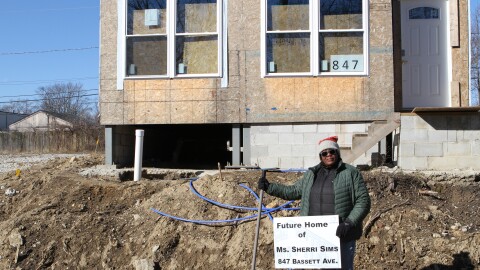At the Reeb Center, dozens of Columbus residents file through a small gymnasium. They’re submitting applications for a spot in a 60-unit development dedicated to seniors going up a block away on the corner of Parsons Avenue.
After years of helping low income residents buy homes, South Side affordable housing developer Community Development For All People (CD4AP) started worrying it might be contributing to the factors pushing longtime residents out of the neighborhood.
So they’re shifting their focus and working to become a landlord instead. It’s an ambitious effort to control a large chunk of the local rental market to help put the brakes on rising rents.
Rev. John Edgar heads up the organization, which is partnering with Cleveland-based NRP Group on the project called Parsons Village Two. They have a very particular demographic in mind:
“Folks who are over the age of 55 and whose income is less than 60 percent of the average income for people in central Ohio,” Edgar explains.
Edgar says helping a family buy a home is great in the short term: Vacant or blighted structures get improved and people get housing. But after a while, those improvements help nudge housing costs higher, and organizations like Edgar’s have fewer options to provide affordable housing.
“We are committed to having a sustainable, mixed income neighborhood here on the South Side,” Edgar says. “And to do that we’ve become convinced that we have to become landlords at scale.”

By becoming landlords, CD4AP hope to maintain their influence over prices for a longer term. Edgar believes if they can control 15 to 20 percent of rents, either directly or through partnerships, they can help offset market forces.
“The hope is that that creates an impact on the other 80 percent as well,” Edgar says.
The median rent in this census tract is about $750, and just north of here it tops $900. But two-bedroom units in the new development are just $650. Among the people applying for a spot, the need for more and more affordable housing is obvious.
“That’s important—really important to me,” Elaine Robinson says.
Robinson is sitting along the wall with a handful of other applicants waiting to submit the last of their paperwork.
“I need my own roof over my head. I’m living from piddle to post,” she says. “I’m living there and I’m living here, and I’m tired of that. I need my own.”
But the Urban Institute’s Corianne Scally has some doubts about how effective the organization’s broader effort will be. She says the closest comparison to the idea comes from municipal rent control policies.
“Folks living in those controlled units benefit, but folks in the surrounding community might experience kind of a rent increase in effect due to the restrictions that it puts on supply,” Scally says.
She notes the increase in nearby housing costs is modest. And for their part, CD4AP is adding to supply. At the Reeb Center, the senior development everyone hopes to join wouldn’t be under construction without their input.
Despite her doubts about neighborhood-wide impacts, Scally says the organization’s shift toward rentals probably won’t hurt, and she’s curious to see if their plan teaches us something new.
But if the idea is to reduce neighborhood displacement, is there an existing strategy that Edgar and others should be trying instead? “The short answer is no,” Scally says.
“If we had a good solution, I'm sure it would be deployed across the country by now given the number of places that are struggling," Scally continues.
Construction on Parsons Village Two is wrapping up soon, and if everything goes to plan, they hope for residents to move in this summer.
If you have questions about how affordable housing works in Columbus, or if you have a story to share, contact WOSU at nick.evans@wosu.org.






